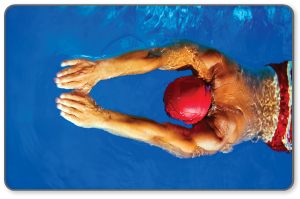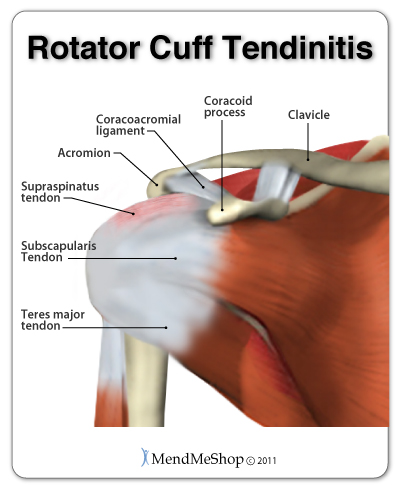There are four tendons that make up the rotator cuff; the supraspinatus tendon, the infraspinatus tendon, the teres minor tendon, and the subscapularis tendon. These tendons are responsible for supporting the shoulder joint and allowing it the freedom to rotate as needed. All of their names refer to muscles of the same name that they attach to. All tendons attach to the glenohumeral joint.

Any injury to the tendons in your rotator cuff can be referred to as rotator cuff tendinopathy. The suffix "pathy" means suffering or disease, therefore tendinopathy is a general term that is used to describe any condition of a tendon.
To describe the exact injury of a tendon, the terms tendinitis (also spelled tendonitis), tendinosis, and tenosynovitis are used.
Tendinopathy is commonly used by health care professionals to refer to the combination of tendonitis and tendinosis in the same tendon. It is common for both to occur at the same time in a tendon.
Rotator cuff tendons are very susceptible to injury, given the instability of the shoulder joint and the fact that we use our shoulder joints for so many things in day to day life. All tendons, by nature, receive very little blood flow. This prevents certain areas of the tendons from getting adequate blood supply in order to repair and maintain themselves to keep up with daily use. If the tendon can not repair itself as damage occurs, tendonitis and other tendon injuries begin to occur.
When referring to any type of rotator cuff tendinopathy, it could be one, some, or all of the tendons involved in the rotator cuff. However, the supraspinatus tendon is the rotator cuff tendon that is most susceptible to injury. Due to its location at the top of the shoulder, between the joint cavity and the acromion, the tendon is at risk of impingement. It also functions to allow the arm to abduct (move away from the body) and is used for many daily activities which can lead to overuse tendon conditions.

The suffix "itis" means something is inflamed; therefore, the term rotator cuff tendonitis is used when a tendon in the rotator cuff is inflamed. Inflammation in a rotator cuff tendon is often due to irritation and/or micro-tearing of the collagen fibers. When the fibers tear, they become weaker, inflamed and swollen causing pain and tenderness in the area.
There are 2 types of rotator cuff tendonitis; acute and chronic. Acute tendonitis refers to inflammation that comes on suddenly, usually from a shoulder injury, such as a dislocation, or overloading it during exercise. Chronic tendonitis occurs over time and generally results from long term repetitive use of one or some of the rotator cuff tendons.
With both types of tendinitis, scar tissue develops on the tendon(s) as the tears to heal. This scar tissue mends the tears in an abnormal way leaving the collagen fibers connected, but weaker and more prone to further injury. In the case of chronic tendinitis rotator cuff tendon(s) may actually become thicker with a build up of scar tissue over a long period of time, making it more prone to impingement in the subacromial space.
The term tendinosis refers to the non-inflammatory, degeneration, and weakening of the collagen fibers in a tendon. This tissue break down is often caused by repetitive stress on the fibers of the rotator cuff tendons and failure of the fibers to heal. If the rate of tissue damage exceeds the healing process rate, then eventually the accumulation of damage on the rotator cuff tendon is not able to heal properly. The collagen fibers eventually deteriorate to a point where the once straight, strong, flexible bundle is weakened by abnormally formed fibers that look more like a mess of strands.
You may not feel any pain with tendinosis, which can lead to more damage as you continue to use the tendon. Since there is no inflammation either, you will not experience swelling, heat, redness or the significant pain that often accompanies inflammation.
Tenosynovitis, also called paratendonitis or peritendinitis, is a term used to describe inflammation and degeneration of the tendon's outer layer or sheath. Depending on the tendon, the sheath is also called the synovium or paratenon.
It is possible to suffer from tenosynovitis alone or in conjunction with the degeneration of the tendon(s), called tendinosis. In either case, as your body tries to heal, scar tissue forms inside the sheath, attaching the inner tissues of the tendon(s) to its outer covering, the paratenon. This scar tissue limits the gliding movement of the tendon in the paratenon reducing the range of motion and causing pain, tenderness, redness and swelling.
Tenosynovitis is not common in the rotator cuff tendons but is often a condition of the long bicipital tendon, one of the two biceps tendons attaching the biceps to the humeral head at the shoulder. Biceps tenosynovitis causes pain in the rotator cuff and upper arm and may continue down the arm to the elbow.
Your doctor may take an x-ray to look for fractures, a loss of joint space in the shoulder, bone spurs or calcification in the tendon. An MRI may also be ordered to look at the soft tissue in the rotator cuff. This will give your doctor a clear picture of the muscles, tendons and ligaments in the shoulder, and will allow him or her to assess any damage.
These assessments, along with some range of motion tests performed by your doctor, will determine the treatment options available to you. Treatment options will likely include physical therapy, supervised stretching and targeted exercises, cold compression, therapeutic ultrasound, heat therapy and rest of the affected tendons. You will find that
Click HERE to Go To Our Online Store We take all major credit cards and Paypal.
If you have questions, call our office at 1-866-237-9608 (toll free continental US).
We are currently offering FREE SHIPPING and a 60 day trial period on all our Wraps.
Product specialists are available 9:00 am to 5:00 pm Eastern Standard Time Monday to Friday.
If any question or concern arises, call us or simply send us an email at any time (we check our emails constantly all throughout the day and night.. even on holidays!). We will respond as soon as possible.
Learn more about Shoulder Surgery and Post-Surgery Recovery
Learn more about about how the Circulatory Boost TShellz Wrap® helps with the healing process.
Learn more about which is better for your rotator/shoulder injury - ice or heat
During your recovery, you will probably have to modify and/or eliminate any activities that cause pain or discomfort at the location of your soft tissue injury until the pain and inflammation settle. The more diligent you are with your treatment and rehabilitation, the faster you will see successful results!
Please be aware that this information is neither intended nor implied to be a substitute for professional medical advice. CALL YOUR HEALTHCARE PROVIDER IMMEDIATELY IF YOU THINK YOU MAY HAVE A MEDICAL EMERGENCY. Always seek the advice of your physician or other qualified health provider before using any of our outstanding products to make sure they're right for you and your condition or if you have any questions regarding a medical condition. Always see your doctor for a proper diagnosis as there are often many injuries and conditions (some very serious) that could be the cause of your pain.
© 2025 In.Genu Design Group, Inc. Contact Us